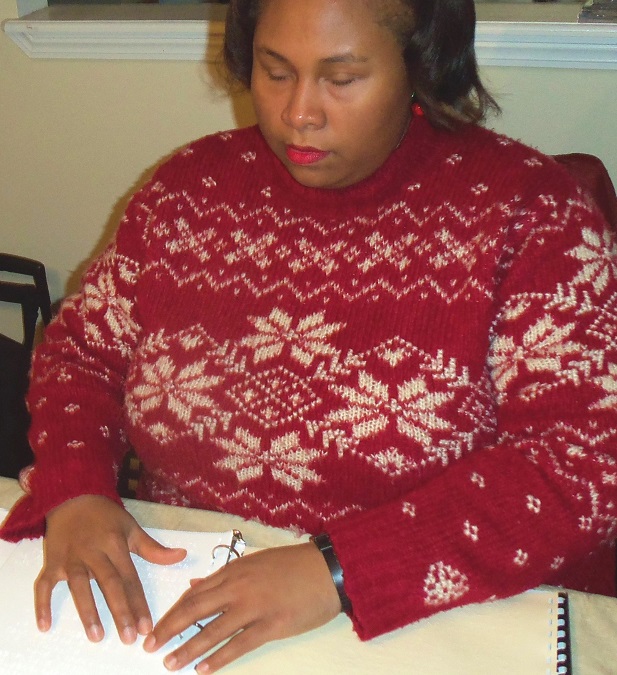
In August 2017, there was a total solar eclipse in the United States. I wrote about it for VisionAware. Now, it is time again and I am sharing some ways people with vision loss can join in on this celestial experience. On Apr 8 there will be another total solar eclipse. Solar eclipses occur somewhere on earth about once every year and a half. A solar eclipse occurs when the moon blocks the disk of the sun. As a result, the day will darken, lasting for only a few minutes. It is an incredible sight to see but very unsafe to do so because of the radiation that is released.
Safe Ways to View an Eclipse

Watching a solar eclipse can cause permanent damage to the eye’s retina, and Prevent Blindness gives some great tips to help protect your eyes. Staring directly at the eclipse or viewing it through an optical aid like binoculars, a telescope or optical camera viewfinder is harmful. Instead, people wear special sunglasses that have a solar filter for protection. Safe solar filters provide a view of the sun that is comfortably bright (like the full moon), in focus, and surrounded by a dark sky.
Another way to safely view the solar eclipse is through indirect projection. According to NASA, this is done by projecting an image of the sun’s disk onto a white piece of paper or card using a pair of binoculars (with one of the lenses covered), a telescope, or another piece of cardboard with a small hole in it (about 1 mm diameter), often called a pinhole camera. The projected image of the sun can then be safely viewed. Caution must be taken to not look directly through the projector.
If the two techniques above don’t work because of your vision loss there are other ways to participate in this natural phenomena. Below I have listed how you can actively engage in our next historical eclipse. Don’t miss out. Get ready because the next one won’t happen for another 20 years!
1. Podcast on Blind Astronomy
One of my favorite blind podcast, Eyes on Success, re-aired an episode about astronomy and blindness. You can listen in preparation for the solar eclipse. The episode is title, “Seeing the Stars His Own Way.” Morgan Rehnberg, a blind astronomer, discusses how astronomy is often thought of as based on visual observation. That they must be transformed to be perceived by humans. Listen and learn how he works as a blind astronomer.
2. View Eclipse with AIRA
Join Aira and the South East Area Coalition of Rochester, NY, for the “Total Eclipse of the Park” event . It will be held at Genesee Valley Park, which is situated directly in the path of totality. This once-in-a-lifetime solar eclipse viewing experience will be enhanced with Aira’s live visual interpretation, ensuring the blind and low vision community can partake in the astronomical spectacle alongside 31 million others in the path of totality.
From 2 p.m. to 4 p.m. Eastern time, Aira’s visual interpreters will bring the eclipse to life via Aira’s YouTube channel, adding insights on the appearance of the sky, the sun’s corona during totality, and capturing the reactions of park patrons as day turns to night. This live broadcast will be streamed throughout Genesee Valley Park during the totality, making it a truly inclusive event. Access this event on the Aira’s YouTube channel.
3. Feel the Rumble with Soundscapes
The Eclipse Soundscapes by ARISA Lab, L.L.C will offer an eclipse opportunity through their app. This app is a multi-sensory experience for people of all learning styles to engage with astronomical events, including total solar eclipses. Inside this app, you will find countdowns to major astronomical events in your area and real time narrations of those events, along with illustrative audio descriptions provided by the GBH National Center for Accessible Media. You can also explore the cosmos with high-quality photos, educational information and accessible learning tools.

Feel the eclipse as it happens. Features include the following:
An interactive tactile1. “rumble map”.
2. Audio descriptions of key features of an eclipse.
3. A play-by-play description while a solar eclipse is happening in the user’s area.
4. a countdown clock to the next upcoming solar eclipse.

The “rumble map” gives the user the sensation of “feeling” the sun during an eclipse. Their technology translates images of key eclipse features into a series of unique frequency-modulated tones that map out variations in light and dark as the user explores the image with their fingertips. These tones are specially designed to make the user’s mobile device shake, or rumble, in response to the changes.
After the eclipse, the Eclipse Soundscapes app will provide access to educational and interactive eclipse information. During the next five years, the app will expand to include other eclipses and astronomical objects of interest, giving people with low vision, blindness and even everyone else a new way to engage with the universe around them.
4. Read a Braille Eclipse Guide

For braille readers, NASA created a solar eclipse tactual guide. It is called “Getting a Feel for Eclipses.” The book is designed to depict basic concepts about the interaction and alignment of the Sun with the Moon and Earth during a solar eclipse. This book educates the sighted and blind on the science of eclipses by adding the sense of touch to their learning experience.
After reading this post how will you view the solar eclipse? Do any of the above options peak your interest? Or do you have another way to view it? Let’s get ready to share in this historical and spectacular event.
Leave a comment